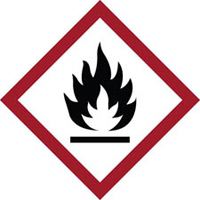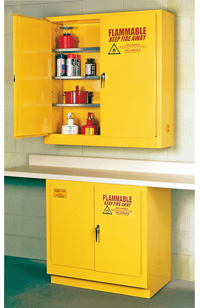



Find all of your laboratory and workplace safety supplies at Safety Emporium!
 Flammable |
 Glossary Index |
 Flammable Gas |
| MSDS Topics |
Free Sites | FAQ's | Regulations | Glossary | Software | Suppliers |
| Books | Forum | Poll | Fun stuff | Quiz | Store | |
| Understand your MSDS with the MS-Demystifier | Search ALL our MSDS info | |||||
Under Appendix B of 29 CFR 2910.1200, the OSHA Hazard Communication Standard (HCS 2012), a flammable aerosol is defined as an aerosol which contains a flammable liquid, flammable gas or flammable solid but doesn't merit classification into one of those categories on its own and meets one of these following two criteria:
| Category | Criteria |
| 1 | Contains ≥ 85% flammable components and the chemical heat of combustion is ≥30 kJ/g; or
(b) For foam aerosols, in the aerosol foam flammability test (i) The flame height is ≥ 20 cm (7.87 in) and the flame duration ≥2 s; or (ii) The flame height is ≥ 4 cm (1.57 in) and the flame duration ≥7 s. |
| 2 | Contains > 1% flammable components, or the heat of combustion is ≥20 kJ/g; and
(i) Time equivalent is ≤300 s/m3; or (ii) Deflagration density is ≤ 300 g/m3 (b) For foam aerosols, in the aerosol foam flammability test, the flame height is ≥4 cm and the flame duration is ≥2 s and it does not meet the criteria for Category 1 |
An aerosol is a suspension of fine solid particles or liquid droplets in a gas. Examples are smoke, smog and tear gas. Compare this to the definitions of mist and dust.
An aerosol can also describe a container which dispenses a material that forms an aerosol as it is dispensed. OSHA defines such containers as "Aerosol means any non-refillable receptacle containing a gas compressed, liquefied or dissolved under pressure, and fitted with a release device allowing the contents to be ejected as particles in suspension in a gas, or as a foam, paste, powder, liquid or gas."

Flame pictograms and other GHS-compliant labels and signs are available from Safety Emporium.
Prior to the adoption of 2012 version of 29 CFR 1910.1200, the OSHA Hazard Communication Standard (HCS 2012), OSHA defined a flammable aerosol more simply as "an aerosol which is required to be labeled flammable under the Federal Hazardous Substances Labeling Act... For the purposes of paragraph (d) of this section, such aerosols are considered Class IA liquids."
Likewise, the previous version of the HCS defined a flammable aerosol as "an aerosol that, when tested by the method described in 16 CFR 1500.45, yields a flame projection exceeding 18 inches at full valve opening, or a flashback (a flame extending back to the valve) at any degree of valve opening;
HCS 2012 was adopted to bring US Safety Data Sheets into alignment with the Globally Harmonized System, thus the revised defintion is based on a globally accepted and scientific designation rather than by reference to US laws or less rigorous methods. Obviously, the HCS 2012 definition is much more unwieldy. In layman's terms, one could say a flammable aerosol is one that is easily ignited (catches fire) when exposed to a flame or spark.
The labeling provisions of HCS 2012 require that Category 1 or 2 flammable aerosol containers carry the flame pictogram (shown on the right) to provide a quick visual warning of the flammability hazard. The GHS does not require these symbols to appear on the SDS itself, however most responsible manufacturers will do so to preserve the correspondence between a substance's SDS and label.

Store your aerosol cans safely with flammable storage safety cabinets from Safety Emporium.
The HCS 2012 alignment with the GHS established a standard 16-part format for Safety Data Sheets (SDS's). Section 9 of the SDS contains physical and chemical properties and flammability is one of those that must be listed. Additional information for flammable aerosols might also be found in other sections such as conditions to avoid, disposal considerations etc. but is not required.
Flammable aerosols can be quite hazardous. Use caution when using materials such as spray paints or aerosol solvents to avoid accidental ignition by a heat source or open flame. Some equipment may not be adequate to keep a flammable aerosol from flashing back into the container and result in an explosion or deflagration.
Most SDS's and fire safety experts recommend storing flammable aerosols in a flammable liquid storage cabinet. These are sold commercially by many vendors.
See also: flammable, flammable gas, flammable limits, flash point.
Additional definitions from Google and OneLook.
Entry last updated: Thursday, October 6, 2022. This page is copyright 2000-2025 by ILPI. Unauthorized duplication or posting on other web sites is expressly prohibited. Send suggestions, comments, and new entry desires (include the URL if applicable) to us by email.
Disclaimer: The information contained herein is believed to be true and accurate, however ILPI makes no guarantees concerning the veracity of any statement. Use of any information on this page is at the reader's own risk. ILPI strongly encourages the reader to consult the appropriate local, state and federal agencies concerning the matters discussed herein.